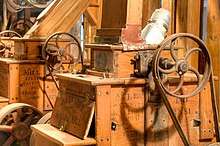Roller mill
Roller mills are mills that use cylindrical rollers, either in opposing pairs or against flat plates, to crush or grind various materials, such as grain, ore, gravel, plastic, and others. Roller grain mills are an alternative to traditional millstone arrangements in gristmills. Roller mills for rock complement other types of mills, such as ball mills and hammermills, in such industries as the mining and processing of ore and construction aggregate; cement milling; and recycling.



Types
Two-roller mills Two-roller mills are the simplest variety, in which the material is crushed between two rollers before it continues on to its final destination. The spacing between these two rollers can be adjusted by the operator. Thinner spacing usually leads to that material being crushed into smaller pieces.
Four-roller mills Four-roller mills have two sets of rollers. When using a four-roller mill to mill grain, the grain first goes through rollers with a rather wide gap, which separates the seed from the husk without much damage to the husk, but leaves large grits. Flour is sieved out of the cracked grain, and then the coarse grist and husks are sent through the second set of rollers, which further crush the grist without damaging the crusts. Similarly, there are three-roller mills, in which one of the rollers is used twice.
Five- and six-roller mills Six-roller mills have three sets of rollers. When using this type of mill on grain, the first set of rollers crush the whole kernel, and its output is divided three ways: Flour immediately is sent out the mill, grits without a husk proceed to the last roller, and husk, possibly still containing parts of the seed, go to the second set of rollers. From the second roller flour is directly output, as are husks and any possible seed still in them, and the husk-free grits are channeled into the last roller. Five-roller mills are six-roller mills in which one of the rollers performs double duty.
Gristmill conversion
In the 19th century roller mills were adapted to grist mills before replacing them. The mill used either steel or porcelain rollers.[1] Between the years 1865 and 1872, the Hungarian milling industry upgraded and expanded the use of stone mills combined with roller mills in a process known as Hungarian high milling. Hungarian hard wheat so milled was claimed as integral to the "First in the world" success of the Vienna Bakery of the 1867 Paris Exposition.[2]
Other applications
- Specialized for the high production of superfine pyrophyllite powder making in glass fiber industry
- Specialized for the high production of gangue powder making in coal industry
- Specialized for the high production of various of chemical raw material powder making in the chemical industry.
Working principle
While working, motor drives the hanger of the grinding roller to rotate through V pulley and centre bearing. The roller, which is hung by bearing and pendulum shaft, will roll along the inner circle of the roll ring while the hanger is rotating. A dust removal blower will generate negative pressure at the inlet and outlet of the grinder to prevent dust and radiating the heat in the machine.
History
Sugar rolling mills first appeared in the Mughal Empire, using the principle of rollers as well as worm gearing, by the 17th century. The Indian roller mills used the principle of rollers as well as worm gearing.[3]
See also
References
- Flour Milling History What Makes Bread Rise?. oldrecipebook.com. Accessed 2010-11-26
- Eben Norton Horsford (1875). Report on Vienna bread. Washington: Government Printing Office. pp. 75–76. Retrieved 2012-10-31.
- Irfan Habib (2011), Economic History of Medieval India, 1200-1500, page 53, Pearson Education